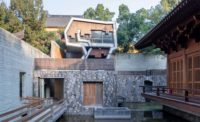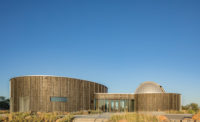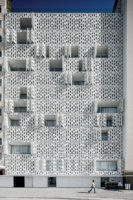Overlooking a small cove off the East River in the shadow of the Brooklyn Bridge, a group of four- and five-story former warehouses, built in 1869 and 1885, respectively, had been languishing for over half a century, vacant and disused. Now, nearly 150 years since their construction, the Empire Stores, as they were called, are thriving again as an integral part of New York’s Dumbo neighborhood and the waterfront development in Brooklyn Bridge Park. A thoughtful intervention by Studio V Architecture and S9 Architecture not only maintains the integrity of the existing structures—designated New York State landmarks in 1978—it knits them into a single entity, transforming the 350,000-square-foot timber and masonry facility (once largely used for warehousing coffee) into a lively blend of commercial and public spaces that includes a 100,000-square-foot roof addition, 50,000 square feet of green roofs, and a 7,000-square-foot extension of the park that climbs to the roof.
Additional Content:
Jump to credits & specifications
The brief from the Brooklyn Bridge Park Corporation (BBPC)—the city’s not-for-profit organization that oversees the park’s planning, construction, and operation—mandated an ambitious mixed-use program that would engage the community and provide revenue for the park. (Empire Stores is one of a select group of developments within Brooklyn Bridge Park that, in lieu of taxes, contributes about 90 percent of the park’s annual operating costs of $12 million plus.) The project must also conform with New York State’s Historic Preservation Office (SHPO) guidelines.
The challenges involved in achieving these goals were formidable. In 2013, when former mayor Michael Bloomberg announced that developer Midtown Equities, in partnership with HK Organization and Rockwood Capital, won the bid to convert and expand Empire Stores, the building was near collapse, from decades of neglect, compounded by the ravages of Hurricane Sandy a year earlier.
“It was a diamond in the rough,” recalls Jack Cayre, president of Midtown Equities and a Brooklyn native who had long admired the complex. The seven contiguous structures that make up Empire Stores were supported by a tight wood-column grid and separated by load-bearing solid schist walls, a typical method of fire prevention. The seven-wythe-thick brick facades that surrounded them were punctuated by more than 400 arched openings with no glass, just heavy steel shutters to protect the interiors from the elements.
“This thing was built to take a huge amount of load,” says Silman structural engineer Pat Arnett. “We found the capacity to be 250 pounds per square foot or higher.” And it was built to last, with its dense masonry walls and redundancy of timber columns (though many had collapsed over time). “The building is so robust,” says Arnett, “you could knock a lot of the columns out and it still would stand.”
Such stability would prove invaluable in the reconstruction of the building. The original timber piles had rotted away, and it needed a new foundation. To do this, the engineers had to shore up the structure, which they did by boring holes 4 feet on center through the base of the schist walls, then inserting steel beams through them. This enabled the crew to drive new helical piles below the structure and pour a 3-foot-thick mat foundation underneath the beams. A gravel bed on top of the mat, and beneath the concrete ground floor, conceals the beams and mitigates water infiltration. Other strategies for dealing with rising tides include water-resistant materials for the ground floor, mechanical systems located above the floodplain on top of the loading dock, and a deployable flood fence around the building.
The structure is so amazing, says Studio V principal Jay Valgora, that “we wanted to reveal the making of the building.” The design retains the rigorous facade, in accordance with landmark requirements, as well as the timber columns and beams, and much of the stone. Yet radical measures were necessary within its shell: to improve circulation; increase financial viability by adding two and a half stories of space; and introduce 21st-century systems.
One of Valgora’s most significant strategies was to crack through the building’s vast 450- by 190-foot footprint and slice open a central masonry wall to create a diagonal passage, which connects the activity of the street with the revitalized waterfront. The resulting public lobby offers dining and shopping opportunities and flows into a four-story outdoor courtyard carved out of the building within the original walls and encircled by a glazed curtain wall. Here, discreetly tucked behind the facade’s brick arches, the architects erected a sequence of Piranesian stairs, catwalks, and bridges that lead up to a Brooklyn Historical Society museum on the second level and the landscaped rooftop park, where plans for a beer garden are in the works.
On the way up, visitors can peer through sections of glazing to see the extent of the restoration in various offices, where areas of schist have been blown out and the arches enclosed by a clever window system, which maintains the look of the historic curved opening by framing the glass on the wall behind it, not within it like traditional windows’.
To enhance the building’s revenue potential, the BBPC approved the rooftop addition, which raises the building’s height to seven stories. Its appropriateness within the surrounding cityscape was key, says S9 Architecture’s Navid Maqami, as was its setback. Like the curtain wall’s, the design is based on an industrial aesthetic, with an obsidian-hued steel-and-concrete structure that appealed to local community advocates, SHPO, and the city’s Landmarks Preservation Commission, which had an advisory role.
Since the first occupant arrived in the fall of 2016—the headquarters and a street-level store for West Elm—Empire Stores has become extremely popular, attracting tenants like Shinola, United Technologies, Wasserman Media, and Soho House, the London-based venture, which opened a restaurant on the park below and installed Dumbo House, one of its clubs, on the upper floors, with a terrace and pool deck.
The building has also been luring locals and tourists for its hip, evocative vibe and spectacular views of the Manhattan skyline. Even on a recent brisk winter morning, Dumbo House was packed with freelancers working, while visitors climbed to the terraces outside. “It’s a theatrical experience,” says Maqami. “People even come up to take wedding pictures.”
CreditsArchitect: Studio V Architecture, 44 East 32nd Street, New York, NY 1001, 212.779.2288, www.studiov.com S9 Architecture, 460 West 34th Street, New York, NY 10001, www.s9architecture.com
Personnel in architect's firm who should receive special credit: Studio V Architecture: Jay Valgora, pricipal; John Maccallumm, Gordon Wilhelm, Guido Furlanello, Gianfranco Cerini, Sishir Varghese, Andy Wu, design team. S9 Architecture: Navid Maqami, John Clifford, Sital Patel, principals; Carl Yberg, Yu Duk So, George Chin, Daniel Cheng, Rolexi Pinzon, Julia Stokien, Bhushon Mondakar, design team
Associate architect: Perkins Eastman, 115 5th Avenue, New York, NY 10003, www.perkinseastman.com
Engineers Structural Engineer: Robert Silman Associates Mechanical Engineers: Mottola Rini Expeditor: SRA Engineer Geotechnical: RA Consultants
Consultants Landscape Designer: Future Green Studios Lighting Designer: Tillotson Design Associates Sustainability Consultant: Spiezle Architecture Group Historic Consultant: Higgins Quasebarth & Partners Code: Code Consultants Site Surveyor: Building Survey Corp and Control Point Associates
General contractor: Veracity Partners
Photographer: Imagen Subliminal, Patrick Donahue, David Rahr, K. Taro Hashimura, Lester Ali, Max Tohey, Patrick Donahue, Raimund Koch
|
SpecificationsExterior Cladding Masonry: existing Metal panels: Kingspan Metal/glass curtain wall: KPA Studio Wood: existing
Roofing Built-up roofing: Siplast Other: Advanced Green Architecture, roof deck pavers on pedestals
Windows Metal frame: YKK AP
Glazing Glass: Vitro Architectural Glass
Doors Entrances: YKK AP Upswinging doors, other: B & B Iron Works Corp.’ overhead doors
Hardware Locksets: Yale Closers: Norton Exit devices: Yale Pulls: Rockwood
Interior Finishes Paints and stains: Benjamin Moore Floor and wall tile: Nasco Concreti and Nasco Metro Special interior finishes unique to this project: American Bluestone, reclaimed lumber
Lighting Interior ambient lighting: Expressive Lighting Downlights: Expressive Lighting Exterior: Expressive Lighting Dimming system or other lighting controls: Leviton
Conveyance Elevators/escalators: Rotavele Elevator Accessibility provisions: Wheelchair Lift: Handi-Lift
Plumbing Toilets: American Standard Urinals: American Standard Undercounter Sinks; American Standard Faucets: Moen Drinking Fountain: Elkay Mop Receptor: Florestone |

















Post a comment to this article
Report Abusive Comment